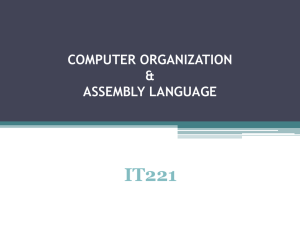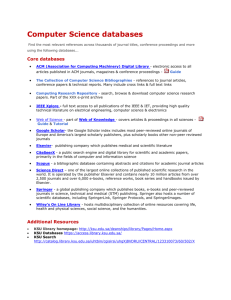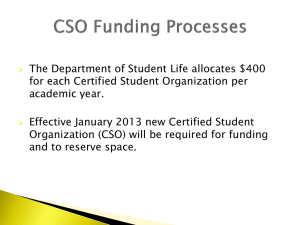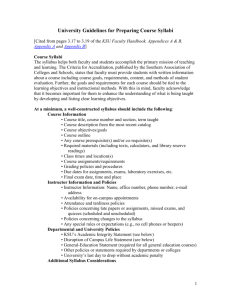Physics Beliefs in Saudi Arabia: A CLASS Survey Analysis
advertisement
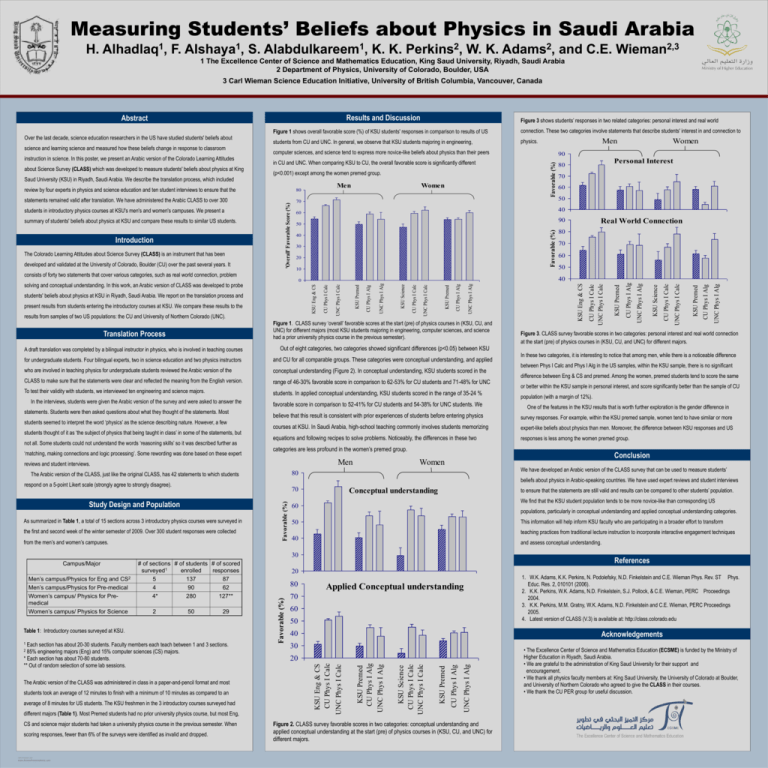
Measuring Students’ Beliefs about Physics in Saudi Arabia H. 1 Alhadlaq , F. 1 Alshaya , S. 1 Alabdulkareem , K. K. 2 Perkins , W. K. 2 Adams , and C.E. 2,3 Wieman 1 The Excellence Center of Science and Mathematics Education, King Saud University, Riyadh, Saudi Arabia 2 Department of Physics, University of Colorado, Boulder, USA 3 Carl Wieman Science Education Initiative, University of British Columbia, Vancouver, Canada Results and Discussion Abstract (p<0.001) except among the women premed group. Out of eight categories, two categories showed significant differences (p<0.05) between KSU for undergraduate students. Four bilingual experts, two in science education and two physics instructors and CU for all comparable groups. These categories were conceptual understanding, and applied who are involved in teaching physics for undergraduate students reviewed the Arabic version of the conceptual understanding (Figure 2). In conceptual understanding, KSU students scored in the CLASS to make sure that the statements were clear and reflected the meaning from the English version. range of 46-30% favorable score in comparison to 62-53% for CU students and 71-48% for UNC To test their validity with students, we interviewed ten engineering and science majors. students. In applied conceptual understanding, KSU students scored in the range of 35-24 % students seemed to interpret the word ‘physics’ as the science describing nature. However, a few students thought of it as ‘the subject of physics that being taught in class’ in some of the statements, but not all. Some students could not understand the words ‘reasoning skills’ so it was described further as ‘matching, making connections and logic processing’. Some rewording was done based on these expert categories are less profound in the women’s premed group. Women Favorable (%) 60 populations, particularly in conceptual understanding and applied conceptual understanding categories. This information will help inform KSU faculty who are participating in a broader effort to transform 50 teaching practices from traditional lecture instruction to incorporate interactive engagement techniques 40 and assess conceptual understanding. average of 8 minutes for US students. The KSU freshmen in the 3 introductory courses surveyed had different majors (Table 1). Most Premed students had no prior university physics course, but most Eng, CS and science major students had taken a university physics course in the previous semester. When scoring responses, fewer than 6% of the surveys were identified as invalid and dropped. TEMPLATE DESIGN © 2008 www.PosterPresentations.com 20 80 1. W.K. Adams, K.K. Perkins, N. Podolefsky, N.D. Finkelstein and C.E. Wieman Phys. Rev. ST Phys. Educ. Res. 2, 010101 (2006). 2. K.K. Perkins, W.K. Adams, N.D. Finkelstein, S.J. Pollock, & C.E. Wieman, PERC Proceedings 2004. 3. K.K. Perkins, M.M. Gratny, W.K. Adams, N.D. Finkelstein and C.E. Wieman, PERC Proceedings 2005. 4. Latest version of CLASS (V.3) is available at: http://class.colorado.edu Applied Conceptual understanding 70 60 50 Acknowledgements 40 30 20 UNC Phys I Alg students took an average of 12 minutes to finish with a minimum of 10 minutes as compared to an References CU Phys I Alg The Arabic version of the CLASS was administered in class in a paper-and-pencil format and most UNC Phys I Alg We find that the KSU student population tends to be more novice-like than corresponding US KSU Premed Each section has about 20-30 students. Faculty members each teach between 1 and 3 sections. 2 85% engineering majors (Eng) and 15% computer sciences (CS) majors. * Each section has about 70-80 students. ** Out of random selection of some lab sessions. 1 CU Phys I Alg to ensure that the statements are still valid and results can be compared to other students’ population. Conceptual understanding KSU Science CU Phys I Calc UNC Phys I Calc Table 1: Introductory courses surveyed at KSU. KSU Premed We have developed an Arabic version of the CLASS survey that can be used to measure students’ beliefs about physics in Arabic-speaking countries. We have used expert reviews and student interviews KSU Premed CU Phys I Alg UNC Phys I Alg 29 UNC Phys I Calc Conclusion 80 UNC Phys I Calc 50 CU Phys I Calc responses is less among the women premed group. KSU Eng & CS CU Phys I Calc 2 KSU Science equations and following recipes to solve problems. Noticeably, the differences in these two Favorable (%) Men’s campus/Physics for Eng and CS2 Men’s campus/Physics for Pre-medical Women’s campus/ Physics for Premedical Women’s campus/ Physics for Science population (with a margin of 12%). expert-like beliefs about physics than men. Moreover, the difference between KSU responses and US 70 # of sections # of students # of scored surveyed1 enrolled responses 5 137 87 4 90 62 4* 280 127** or better within the KSU sample in personal interest, and score significantly better than the sample of CU courses at KSU. In Saudi Arabia, high-school teaching commonly involves students memorizing 30 Campus/Major difference between Eng & CS and premed. Among the women, premed students tend to score the same survey responses. For example, within the KSU premed sample, women tend to have similar or more respond on a 5-point Likert scale (strongly agree to strongly disagree). from the men’s and women’s campuses. between Phys I Calc and Phys I Alg in the US samples, within the KSU sample, there is no significant believe that this result is consistent with prior experiences of students before entering physics The Arabic version of the CLASS, just like the original CLASS, has 42 statements to which students the first and second week of the winter semester of 2009. Over 300 student responses were collected In these two categories, it is interesting to notice that among men, while there is a noticeable difference One of the features in the KSU results that is worth further exploration is the gender difference in Men As summarized in Table 1, a total of 15 sections across 3 introductory physics courses were surveyed in Figure 3. CLASS survey favorable scores in two categories: personal interest and real world connection at the start (pre) of physics courses in (KSU, CU, and UNC) for different majors. favorable score in comparison to 52-41% for CU students and 54-38% for UNC students. We reviews and student interviews. Study Design and Population UNC Phys I Alg KSU Eng & CS Figure 1. CLASS survey ‘overall’ favorable scores at the start (pre) of physics courses in (KSU, CU, and UNC) for different majors (most KSU students majoring in engineering, computer sciences, and science had a prior university physics course in the previous semester). KSU Eng & CS 40 results from samples of two US populations: the CU and University of Northern Colorado (UNC). statements. Students were then asked questions about what they thought of the statements. Most 60 0 present results from students entering the introductory courses at KSU. We compare these results to the In the interviews, students were given the Arabic version of the survey and were asked to answer the 70 50 students' beliefs about physics at KSU in Riyadh, Saudi Arabia. We report on the translation process and Real World Connection 80 10 solving and conceptual understanding. In this work, an Arabic version of CLASS was developed to probe A draft translation was completed by a bilingual instructor in physics, who is involved in teaching courses 50 CU Phys I Alg Favorable (%) 20 UNC Phys I Alg consists of forty two statements that cover various categories, such as real world connection, problem 30 CU Phys I Alg developed and validated at the University of Colorado, Boulder (CU) over the past several years. It 40 KSU Premed The Colorado Learning Attitudes about Science Survey (CLASS) is an instrument that has been 50 UNC Phys I Calc Introduction 60 90 CU Phys I Calc summary of students' beliefs about physics at KSU and compare these results to similar US students. 70 40 60 KSU Science students in introductory physics courses at KSU's men's and women's campuses. We present a 80 KSU Premed 70 Women Personal Interest CU Phys I Calc UNC Phys I Calc statements remained valid after translation. We have administered the Arabic CLASS to over 300 'Overall' Favorable Score (%) 80 Men Women 90 Favorable (%) in CU and UNC. When comparing KSU to CU, the overall favorable score is significantly different review by four experts in physics and science education and ten student interviews to ensure that the Translation Process Men computer sciences, and science tend to express more novice-like beliefs about physics than their peers UNC Phys I Alg Saud University (KSU) in Riyadh, Saudi Arabia. We describe the translation process, which included physics. CU Phys I Alg about Science Survey (CLASS) which was developed to measure students' beliefs about physics at King students from CU and UNC. In general, we observe that KSU students majoring in engineering, KSU Premed instruction in science. In this poster, we present an Arabic version of the Colorado Learning Attitudes connection. These two categories involve statements that describe students' interest in and connection to UNC Phys I Calc science and learning science and measured how these beliefs change in response to classroom Figure 1 shows overall favorable score (%) of KSU students' responses in comparison to results of US CU Phys I Calc Over the last decade, science education researchers in the US have studied students' beliefs about Figure 3 shows students’ responses in two related categories: personal interest and real world Figure 2. CLASS survey favorable scores in two categories: conceptual understanding and applied conceptual understanding at the start (pre) of physics courses in (KSU, CU, and UNC) for different majors. • The Excellence Center of Science and Mathematics Education (ECSME) is funded by the Ministry of Higher Education in Riyadh, Saudi Arabia. • We are grateful to the administration of King Saud University for their support and encouragement. • We thank all physics faculty members at: King Saud University, the University of Colorado at Boulder, and University of Northern Colorado who agreed to give the CLASS in their courses. • We thank the CU PER group for useful discussion.
